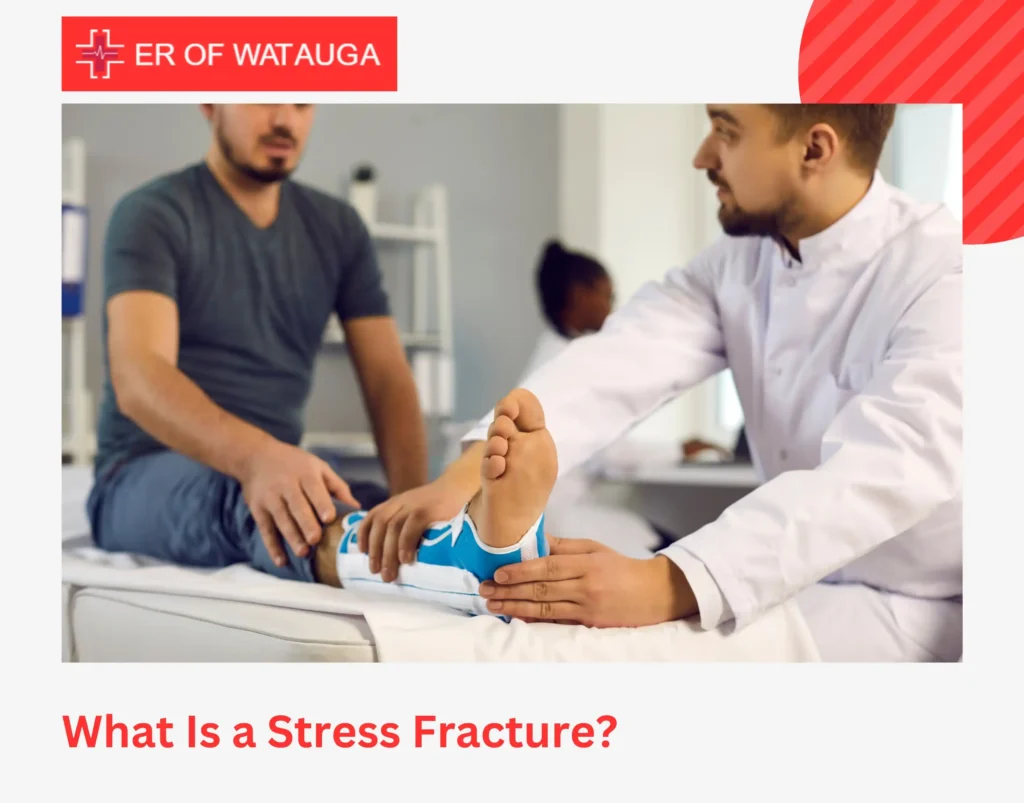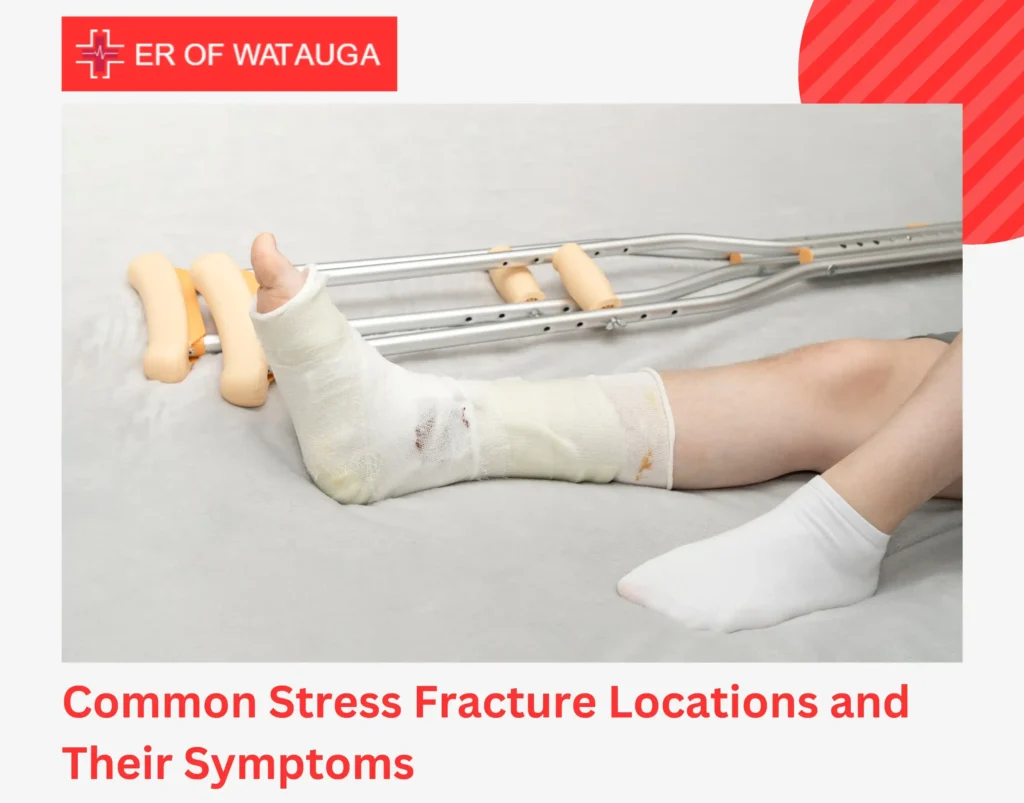Never ignore your foot or shin pain, assuming it’s just a muscle strain. If the pain is persistent, there’s a high chance it could be a stress fracture, a tiny crack in the bone that can turn into a big problem if ignored.
The tricky part is that it develops slowly. Unlike a major bone break that happens suddenly (and hurts a lot), stress fractures start with dull aches in your foot or shin. That’s exactly why many people brush it off as regular soreness or a pulled muscle.
Let’s explore symptoms and what it feels like, so you can save yourself from a longer and more painful recovery.
What Is a Stress Fracture?
Stress fractures are a type of bone injury in which small cracks develop in the bone when it is repeatedly subjected to impact or strain over time. Unlike a traumatic fracture, which occurs suddenly, it forms through ongoing microtrauma that weakens the bone.
They are also known as hairline fractures because of their thin, narrow crack shapes. Activities that involve repetitive impact, such as playing sports, running, or performing physically demanding tasks, can increase the risk of fractures.
Most commonly affect weight-bearing bones, including:
- Tibia (shinbone)
- Metatarsals (foot bones)
- Femur (thigh bone)
- Navicular (midfoot bone)
- Pelvis
5 Common Symptoms
Here are five stress fracture signs that set it apart:
1. Persistent, Localized Pain
One of the earliest indicators is persistent pain in a very specific spot. This pain is typically sharp or aching, and it worsens with weight-bearing activities. Unlike muscle soreness, which spreads over a larger area, stress fracture pain is pinpointed and easy to locate.
2. Pain During and After Activity
Muscle soreness usually sets in after exercise, and pain often starts during physical activity and escalates as the activity continues. As the injury progresses, the pain can linger even after a typical cooldown or rest.
3. Decreased Performance and Limb Weakness
Another symptom is a gradual decline in performance. You might struggle to maintain your usual pace. Some people notice feelings of instability or fatigue in the affected limb. It’s your body’s way of compensating for an injury it’s trying to protect.
4. Bone Tenderness to the Touch
A key way to differentiate a stress fracture from soft tissue injuries is by checking for bone tenderness. If pressing directly on the affected area produces sharp or intense pain, this may be a classic sign.
5. Swelling & Bruising
Sometimes, swelling or mild bruising can develop around the site of the fracture, especially in advanced cases. Swelling or bruising may indicate internal bleeding or inflammation near the damaged bone. If you see puffiness or discoloration, it’s worth getting checked out.
Common Stress Fracture Locations and Their Symptoms
Understanding the location specific stress fracture symptoms can help pinpoint the injury:
Shin (Tibia)
- Dull aching pain that increases with running or jumping
- Tenderness along the inner or outer edge of the shin
Foot (Metatarsals or Navicular)
- Pain on the top of the foot or midfoot
- May be worse when standing or walking for long periods
Hip and Pelvis
- Deep aching pain in the groin or buttocks
- Pain that worsens with weight-bearing activities
- Harder to diagnose due to deeper bone location
Thigh (Femur)
- Pain during impact or activity
- Soreness in the groin or upper leg
- Possible limping
Spine
- Dull, localized pain in the lower back
- Often seen in gymnasts or weightlifters
- Exacerbated by hyperextension or repetitive motion
What Causes a Stress Fracture?
Stress fractures are one form of bone stress injury, which can develop due to multiple contributing factors:
- Repetitive Activity: Activities like running, jumping, and dancing place continuous pressure on bones. Over time, this leads to fatigue and cracks if rest is insufficient.
- Sudden Increase in Training: A rapid change in intensity, frequency, or duration of physical activity can overload the bones, especially if they aren’t conditioned for the new demands.
iii. Improper Footwear or Technique: Worn-out shoes or poor mechanics increase impact forces, making the bones work harder and increasing injury risk.
- Poor Bone Health: Low bone density due to conditions like osteoporosis, or deficiencies in calcium and vitamin D, significantly raise the risk.
- Female Athlete Triad: This includes low energy availability, menstrual dysfunction, and decreased bone density, a triad commonly associated with stress fractures in women.
How Does the ER Diagnose Stress Fracture?
When you reach emergency room with stress fracture symptoms, here’s how they diagnose it:
Medical History and Physical Exam
Your healthcare provider will ask about your physical activity, pain onset, and any recent changes to your exercise habits. They’ll press on the suspected area to detect tenderness.
Imaging Tests
- X-ray: Often inconclusive in early stages
- MRI: Best for identifying early bone stress injuries and soft tissue damage
- Bone Scan: Highlights areas of high bone turnover
Early and accurate diagnosis is essential for optimal stress fracture treatment.
Stress Fracture Treatment Approaches
Proper management of stress fracture symptoms include the following:
- Rest: Stop the activity that caused the injury to allow the bone time to heal. Recovery typically takes 6 to 8 weeks or more, depending on the severity and location of the stress fracture.
- Ice and elevation: Applying ice several times a day and elevating the limb above heart level manage swelling and relieve stress fracture pain.
- Immobilization: A walking boot, crutches, or brace can help protect the affected bone and reduce pressure while it heals.
- Pain relief Medicines: Pain can be managed with over-the-counter medications like acetaminophen. Use anti-inflammatory drugs cautiously, as some evidence suggests they might interfere with bone healing.
- Nutritional support: Getting enough calcium, vitamin D, and protein can aid in bone repair. If there’s concern about bone health, a doctor might recommend a bone density scan.
- Physical therapy: Assist in the later stages of recovery. A physical therapist will guide safe, progressive exercises to rebuild strength and restore mobility.
- Surgical intervention: Rarely needed but may be required for stress fractures that fail to heal with conservative treatment. Stress fracture in high-risk bones like the femoral neck or navicular often needs surgery.
Preventing Future Stress Fractures
After recovering from stress fracture symptoms, prevention should be a priority
- Train Smarter, Not Harder: Gradually increase workout intensity. Follow the 10% rule: don’t increase your training by more than 10% per week.
- Wear Proper Footwear: Choose supportive shoes designed for your activity and replace them regularly.
- Cross-Train: Include low-impact activities like swimming or cycling to reduce stress on weight-bearing bones.
- Strengthen Muscles: Strong muscles absorb impact better and reduce bone stress.
- Prioritize Recovery: Sleep, rest days, and hydration are crucial for bone and muscle recovery.
- Address Nutritional Needs: Ensure adequate intake of bone-supporting nutrients and calories to match your energy output.
Final Thoughts
Don’t let a stress fracture cancel the races or games you’ve trained months for. Head to the nearest emergency room as soon as you notice symptoms, even if they’re mild. Late treatment means you’ll still struggle with lingering pain for months, maybe more.
ER of Watauga is available 24/7 with a board-certified team ready to help. We’ll quickly evaluate your injury using on-site X-rays and advanced imaging, provide fast pain relief, and build a personalized treatment plan that gets you back to activity fast.
FAQs
1. How does a stress fracture happen?
A stress fracture happens when you use a bone too much without giving it time to rest. Doing a lot of running, jumping, or walking, especially if your body isn’t used to it, can cause tiny cracks in the bone.
2. Where does a stress fracture occur?
Stress fractures usually happen in bones that carry your weight, like your foot, shin, or hip. These bones get the most pressure during activities like running, dancing, or sports that involve repetitive motion.
3. When will a stress fracture show on an X-ray?
Sometimes a stress fracture doesn’t show up on an X-ray right away. It can take 1 to 2 weeks before it’s visible. That’s why doctors sometimes use more sensitive imaging, like an MRI or bone scan, if they suspect a stress fracture but the X-ray looks normal.
4. Why doesn’t a stress fracture heal?
A stress fracture won’t heal if you keep using the injured bone without resting. Returning to activity too soon, not following treatment instructions, poor nutrition (especially low calcium or vitamin D), or underlying conditions like osteoporosis can all slow down healing. Proper rest, support, and medical follow-up are key to full recovery.
5. Can I still workout with a stress fracture?
Low-impact exercises like swimming or cycling may be safe, but high-impact activities should be avoided until healing is complete. Always consult a doctor before exercising.









